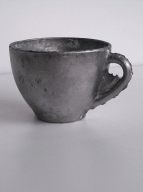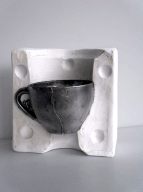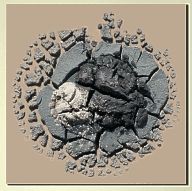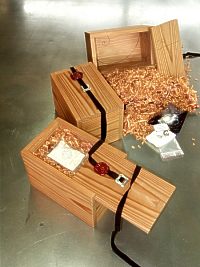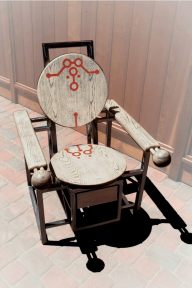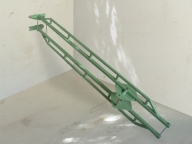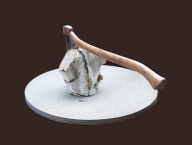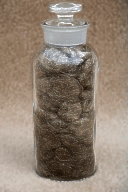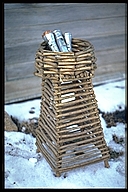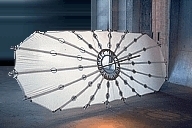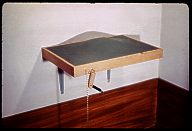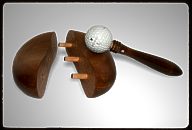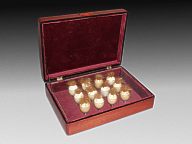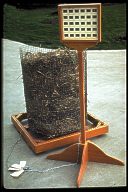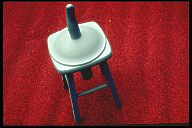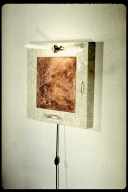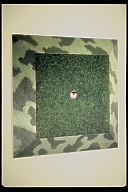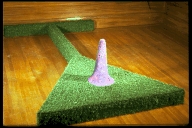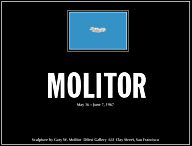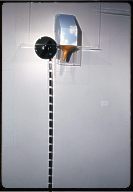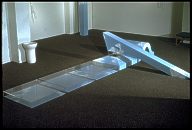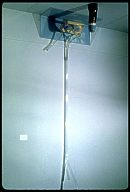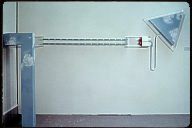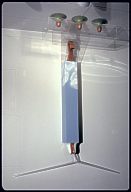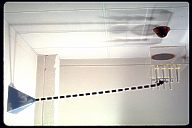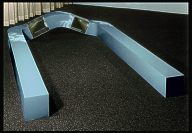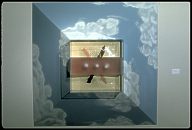Art site of Gary Molitor: Bay Area Art History, California Sculpture, Art Ceramics, Art Cups, Drawings, Sci-Fi 3D Computer Art, Personal Life Stories, Sci-Fi Adventure Stories and of Art Links.
SculptureNew work is added to the top of the list.
To see an enlarged image of the thumbnail image, just click on it, wait and view.
|
| #1
from “Lead Vessel Series,” 2004; 3.5” h - 3.75” w - 3” d. Cast lead alloy This is the first in a series of a study of various vessels using lead as a medium. It is a collaborative effort by Michael D. Cookinham and myself. It is an outgrowth of a recent idea we discussed for a show (Watershed Benefit Auction at Leslie Ceramics) we were asked to show in. One of the concepts that has intrigued me since my college days that was a central focus for Marcel Duchamp, a leader in the Dadaist Movement of the late 1910s. The one piece that Duchamp did that separated contemporary art from classical concepts of art was his "ready made" Porte-bouteilles. It became clear to me that every day objects, when taken out of their preconceived context (normal environment) and placed in an environment that forces the viewer to see it for it true nature, could become art. As pure in expression as anything done during the Renaissance. It wasn't the object itself but that which I bought to the object that made it art. |
| #1
with half mold from “Lead Vessel Series,” 2004; 6” h - 6” w - 6”
d. Cast lead alloy with half of the plaster mold Displaying the cup this way adds another 20th century art concept. Process Art had its early beginnings with the Impressionists but really came into prominence with work the of American Abstract Expressionist Painter, Jackson Pollock (painting). Others took the concept further; Robert Morris, and Robert Smithson. Even the work of Carl Andre, recognized as a Minimalist, can be looked at as Process Art. Sometimes it's hard to tell the difference between Process Art and Conceptual Art and Conceptual Art and Performance art. To some art historians, Marcel Duchamp is a Conceptual artist. |
|
|
|
“Mellow
Madeleines. #05,” 2003; 48" w - 48" d - 8" h. Mixed, calcium carbonate, clay, pigment, organic binder, wood, paper. This is a series of wall piece made while I was at Triangle Coatings. Process Art using materials discarded in the paint making process.
#6 in series, #7 in series. |
|
| “The
Substance of WHAT,” 3/2002, 5"h - 7.5" w - 5"d. Redwood, cloth and plastic. Gifts to Michael Cookinham Jim Stevenson and Chris Unterseher I have always been attracted to the mathematical wonder of the Fibonacci Spiral and its relationship to the Golden Mean. This is a set of identical boxes. On the inside sides, top and bottom of each of the boxes is a different geometric drawing representing and different aspect of the formula for Phi or the square root of five minus one. This inside of the box measures 4" h. x 4" d x 6.5" w. Very close to the formula for the Golden Mean. Each box is filed with cedar wood chips, some of which are in the form of a Fibonacci Spiral. Packed in the chips is a small plastic Zip Lock bag containing a cloth bag with the Greek symbol for Phi printed on either side. The cloth and plastic bag measurements are a Golden Mean. Inside the cloth bag is a square piece of paper with an image of a cone flower on one side and an image of the a spiral galaxy on the other. This piece of paper is folder using a traditional Japanese method for making a paper bindle. Inside the bindle is a small Ammonite Rhondiceras. The box has a black ribbon, a silver clasp, that has little spirals on it, held in place with sealing wax with my seal pressed into the wax. 1.61803398874989484820458683436563811772030917980576286213544862270526046281890244970720720 4189391137484754088075386891752126633862223536931793180060766726354433389086595939582905638 |
|
| “Chair
with Drawer,” Art Chair. 7/2002, 15"h - 11"w - 38"d. Wood and Steel (from the story “Tasux Tæ Bazoüde”) This chair is a replica of one of the chairs that were used at the Table of Jardow. As I recall , this is the chair where the Tibetan Assassin Dkar Yul (full name; Dkar Bkra Ba Skyabs Yul) sat when we dined at the Temple above Galumyth. This chair was made from the White Coyun tree, somewhat similar to our own Bristlecone Pine. The Coyun is aged in the black waters of the lake Paumere for 3 generations. This soaking hardens, preserves and leaves black veins running through the wood, giving it a Zebra like appearance. My replica is only an approximation of this appearance. The symbols that appear on the seat and back are from the old writings of the Scizentheens. This language, as modified by the Rägick, became a picture language and uses three levels of meaning depending on the emotion and tone used in the expression. The Low (battle-fight) translation is "Fear not. The enemy is destroyed". The Middle (common) translation is "Have fun. Help others". And the High (numinous) "Oneness with ALL (Yaweht). You are an instrument of the Creation." Under the seat is a small drawer. In the original, this drawer held the holly Book of Melicha. This book would be interrupted as a spiritual book similar to the Bible, Vedas or Quran. The Rägick have three forms of written language, the Schegg or picture language which is kind of like our road signs, the Rowldon, which the Book Melicha is written in and the supper secrete Arehou. |
|
| “Green
Suspenders and a Copper Tie,” 5/2002, 24" - 72"w - 12"d. Welded steel, painted and assembled. Info. forth coming. |
|
| “Problem
Solver,.” 6/2002, 15"h - 11"w - 38"d. Birch Log and an Ax Its a bitch'n birch. There ain't gonna be any more birching and drain clogging. Tried to save her but she just wasn't worth it. |
|
| “Human
Hairballs” Glass and hair. This is a piece for my ongoing personal documentation. Collections contains over 100 separate pieces. |
|
| “Tower
of Light,” 1979, 42"h - 18"w - 18"d. Alder saplings, gold spray paint and old flash lights. |
|
| “Homage
to Search and Escape From Limitations,” 1970, 52"h - 144"w - 72"d. Linen fabric, leather, bamboo, aluminum. stainless wire and wood |
|
| “The
Scribe,” 1970, 4"h - 22"w - 15"d. Wood fiberglass, plasticeen, found objects |
|
| “By
Split Desision, Molitor on the Ball,” 1971, 3"h - 7"w - 8"d. Wood and golf ball. |
|
| “The
Disciples,” 1970, 6"h - 15"w - 12"d. Wood, Plexiglas, fabric, chicken egg shells and the hair of a dog. Click here for a close up. |
|
| “Simmons
Lane,” 1969 Wood, wire cloth, 35mm slides, glass, dried yard trimmings. |
|
| “This
Ain't No Red Hot Seat of Power,” 1968 Wood, fiberglass and rubber. |
|
| “I
Think You Put Your Finger on It,” 1968 Wood, fiberglass, latex rubber, light bulb,masonite. In the personal collection of Robert Arneson. |
|
| “Ace
the Jack,” 1967 Masonite, pigmented automotive body filler, synthetic fiber, cast vinyl, glass and human hair. Another shape that has intrigued me for many years, is the pyramid and the truncated pyramid. |
|
| “Triune
Nexus,” 1967, 20"h - 36"w - 72"d. Masonite, funeral grass and fiberglass After my show at Dilexi, which was a disappointment (sold one piece) for me and a snubbing by Barbara Rose I had doubts about my current direction. The cloud painted surfaces really started to bother me; they were starting to look immature and gimmicky. Others, I was aware of, were doing similar angular shapes but more in a minalmist way, cleaner. I did not see myself going in that direction. When I looked down that road, all I saw was a dead-end ending with a chrome monolith wall. One of the things that I was working with was some thing I call ironic space (see bellow). Also, about that same time there was a minor movement in the Bay Area called Funk Art. My work was considered part of this movement as I was included in a Major showing of Bay Area Funk Art at the University of Cal, Berkeley Museum assembled by Dr. Peter Selz. I really never felt my work shown at that show contained enough funkiness. |
|
| "Molitor",
Dilexi Gallery One Person Show, May 1967 The work for this show grew out of my graduate work and an experience I had while visiting another artist's studio. On one of my many trips to UC Davis, prior to being hired, I stopped in to see the studio of then graduate student Bruce Nauman. He had a couple of rooms in the old "Married Student Housing," which were slated to be demolished the next year. He had taken the wall out between two rooms to make for a larger space. In doing so there was a five inch gap running from the foot of one side all the way up the wall, across the ceiling and down the other wall. On the floor was the shadow left by the base of the floor. I had an epiphany, "the space is as much a part of the art as the object is". |
|
|
|
||
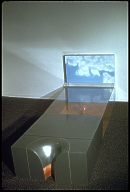 Electric Banana Factory View #2 |
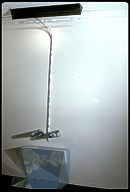 Ride My Crystal Bicycle |
